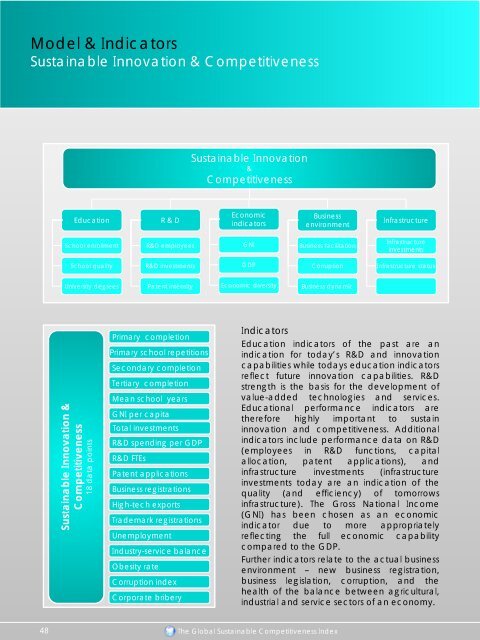Global Competetiveness Report
You also want an ePaper? Increase the reach of your titles
YUMPU automatically turns print PDFs into web optimized ePapers that Google loves.
Model & Indicators<br />
Sustainable Innovation & Competitiveness<br />
Sustainable Innovation<br />
&<br />
Competitiveness<br />
Education<br />
R & D<br />
Economic<br />
indicators<br />
Business<br />
environment<br />
Infrastructure<br />
School enrollment<br />
R&D employees<br />
GNI<br />
Business facilitation<br />
Infrastructure<br />
investments<br />
School quality<br />
R&D investments<br />
GDP<br />
Corruption<br />
Infrastructure status<br />
University degrees<br />
Patent intensity<br />
Economic diversity<br />
Business dynamic<br />
Sustainable Innovation &<br />
Competitiveness<br />
18 data points<br />
Primary completion<br />
Primary school repetitions<br />
Secondary completion<br />
Tertiary completion<br />
Mean school years<br />
GNI per capita<br />
Total investments<br />
R&D spending per GDP<br />
R&D FTEs<br />
Patent applications<br />
Business registrations<br />
High-tech exports<br />
Trademark registrations<br />
Unemployment<br />
Industry-service balance<br />
Obesity rate<br />
Corruption index<br />
Corporate bribery<br />
Indicators<br />
Education indicators of the past are an<br />
indication for today’s R&D and innovation<br />
capabilities while todays education indicators<br />
reflect future innovation capabilities. R&D<br />
strength is the basis for the development of<br />
value-added technologies and services.<br />
Educational performance indicators are<br />
therefore highly important to sustain<br />
innovation and competitiveness. Additional<br />
indicators include performance data on R&D<br />
(employees in R&D functions, capital<br />
allocation, patent applications), and<br />
infrastructure investments (infrastructure<br />
investments today are an indication of the<br />
quality (and efficiency) of tomorrows<br />
infrastructure). The Gross National Income<br />
(GNI) has been chosen as an economic<br />
indicator due to more appropriately<br />
reflecting the full economic capability<br />
compared to the GDP.<br />
Further indicators relate to the actual business<br />
environment – new business registration,<br />
business legislation, corruption, and the<br />
health of the balance between agricultural,<br />
industrial and service sectors of an economy.<br />
48<br />
The <strong>Global</strong> Sustainable Competitiveness Index








